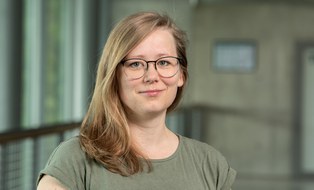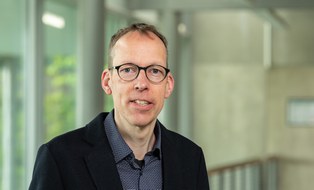Teaching Synergies Program
Teaching Synergies Program (TSP) - Teaching together, learning synergistically
Explanatory film of the Teaching Synergies Program © www.mein-erklaerfilm.de
This is the audio version of the tutorial titled “Teaching Synergies Program at TU Dresden”. What follows is the worded description of illustrations depicting people, buildings, and symbols. A whiteboard shows the header “Teaching Synergies Program at TU Dresden”. Below are two bullet points. The first reads “Gain teaching experience”; the second, “Acquire didactic qualifications”. At the very bottom are the logos of TU Dresden and the DRESDEN-concept alliance.
Looking to gain teaching experience and acquire didactic qualifications, for example, for a professorship? Then follow the example of Amira.
The whiteboard disappears. A female researcher with dark hair and medium complexion is seen in the picture. She is wearing a white coat, protective goggles, and safety gloves. She is holding a test tube and an Erlenmeyer flask in her hands. A silhouette of Dresden’s Old Town can be seen in the back. Behind the young woman, the building of the Helmholtz-Zentrum Dresden-Rossendorf and several trees move into the picture. A thought bubble pops up over her head. Inside the bubble is a ladder. At the top rung of the ladder, a flag is blowing with the word “Professorship”. One of the lower rungs breaks.
Amira is a group leader at the Helmholtz-Zentrum Dresden-Rossendorf. She wishes to prepare for a professorship in the coming years. However, she lacks the necessary teaching experience for this.
A framed poster moves into the picture, covering the scene completely. At the top of the poster a map of Dresden and the surrounding area can be seen. Several colorful little pennants are scattered across the map. The pennants identify the locations of research and cultural institutions that are members of the DRESDEN-concept alliance. Below the map, the logos are allocated to the respective institutions. At the very bottom is the logo of the DRESDEN-concept alliance.
Fortunately, her research facility is a member of DRESDEN-concept, a network of local non-university research and cultural institutions.
The picture fades into a poster hanging on the wall in the study of Amira, the female researcher. Amira is sitting at her desk and typing on a laptop. Next to her is a filing cabinet with multiple folders and a plant on a stool. An envelope flies into the picture. It opens up by itself. A letter flies out of the envelope. It features the logos of TU Dresden and the DRESDEN-concept alliance. The words on the letter are blurry. The header reads “Teaching Synergies Program“.
In a circular emailed by DRESDEN-concept, Amira discovers the Teaching Synergies Program at TU Dresden.
A thought bubble pops up over Amira’s head. The camera zooms into the bubble. Amira is inside an auditorium, standing at a lectern. Her laptop is in front of her on the lectern. Several students are seated on the benches of the auditorium and can be seen from behind. Next to Amira is a screen on a stand. The screen content shows a chart with an alternating curve. Amira is pointing at it.
The Teaching Synergies Program empowers early-career researchers to contribute their research expertise to a course at the TU Dresden, to acquire valuable teaching experience.
The scene cuts to another situation. Amira and another woman, an advisor of the Teaching Synergies Program, are both sitting on chairs at a table. They each have a glass of water in front of them. Stacks of paper are on the table. A sofa and several plants can be seen in the background. An abstract picture is hanging on the wall. The two women are gesturing while talking to each other. Three side-by-side documents overlap the scene. The TU Dresden logo is on every one of them. The header on each of them reads “Profile”. The words on the document are blurry and illegible, and each document shows a portrait photo of a person. One photo is of a man with a light complexion and blond, curly hair. The second of a man with light skin, dark hair, full beard, and glasses. The third shows a woman with dark skin and dark hair. The three documents land on the table in front of the two women. Amira points to the second one – the man with light skin, dark hair, full beard, and glasses. A checkmark appears on this document.
After making an appointment for a personal consultation, Amira receives multiple suggestions for lecturers at the TU Dresden with whom she could teach in tandem. She chooses Thomas, wohose specialism promises to create considerable synergies.
Change of scene. Amira is standing with Thomas, the researcher at TU Dresden that she chose, in front of a whiteboard. The whiteboard shows a mind map made up of many circles and connecting lines. Next to them is the advisor who Amira was speaking with before. She is pointing to the whiteboard. The camera zooms in on Amira. She is drawing a book into one of the circles on the whiteboard. The camera switches to Thomas. He is drawing a microscope into one of the other circles.
Togehter, they design a research-oriented course. Amira benefits from Thomas' teaching experience and Thomas from Amira's exciting research. And the students benefit from twice the expertise.
The scene disappears. Once again, Amira is in her study. She is sitting at her desk and typing on a laptop. Next to her is a filing cabinet with multiple folders and a plant on a stool. A circle is hovering over Amira’s laptop which magnifies the content of her screen. A tab is open on the laptop with the header “Teaching Synergies Program” written in large letters. The words below this are blurred out and illegible. A progress bar filled up to two thirds can also be seen. A cursor moves across the screen and clicks onto a button so that its colour changes.
With the help of a digital self-study course from the Teaching Synergies Program, Amira acquires additional basics in teaching and learning in higher education.
The scene has returned to the auditorium. Amira is standing behind the lectern. Her laptop is in front of her on the lectern. Next to her is Thomas. Several students are seated on the benches of the auditorium and can be seen from behind. Next to Amira and her lectern is a screen on a stand. The screen content shows a curve chart. Amira and Thomas high-five each other.
This turns the course into a complete success.
The scene disappears. Amira and Thomas are standing in front of large windows through which Dresden’s skyline is visible as silhouettes. Next to them is the advisor. The advisor hands a rolled-up certificate to them both. The camera zooms in on Amira. Just as before, a thought bubble pops up over her head. Inside the bubble is a ladder. At the top rung of the ladder, a flag is blowing that says “Professorship”. One of the lower rungs is broken. Amira reaches into the thought bubble and replaces the broken rung with the rolled-up certificate.
Both receive the certificate “Research-oriented Teaching at TU Dresden”. Amira’s application for a professorship now scores not only because of her outstanding research results, but also due to the teaching experience and didactic qualifications she has gained.
Change of scene. Amira and the advisor are in an office. In the background is a filing cabinet, a sofa, and a few plants. A whiteboard is hanging on the wall. The two women are standing in front of it – the advisor is holding a laser pointer in her hand. A progress bar is filling up on the whiteboard. Three symbols appear over the bar: a star, a rectangle that is open at the top with an arrow pointing up, and a checkmark. Below, it says “1st step”, “2nd step”, and “3rd step”. The advisor points to these words one after the other with the laser pointer.
To be even better prepared, Amira is offered coaching afterwards as an additional element of the Teaching Synergies Program. This is where she identifies further steps on her path to becoming a professor and receives support in didactic aspects.
A neutral background overlaps the picture. The words “Teaching Synergies Program“ appear in large letters. The camera zooms in slightly below. A grey block can be seen that reads “Career”. A ladder is leaning against the block. Amira first stands in front of the ladder and then starts climbing up a few rungs. At the top rung of the ladder, she raises a flag that says “Professorship”. The camera switches quickly to the side. Thomas can be seen climbing a mountain. Once at the top, he starts cheering.
The Teaching Synergies Program at TU Dresden thus helped Amira to advance her personal and professional career by gaining teaching experience. It also brought her a big step closer to her dream of becoming a professor. The exchange inspired Thomas with his own teaching and research.
A white background overlaps the scene. It shows the TU Dresden logo. This sentence appears below the logo: “Get in touch with us now!” – below which is the email address, tsp@tu-dresden.de and the URL, www.tud.de/zill/teaching-synergies-program. A small message is visible at the lower edge of the picture: “Funded by the Federal Ministry of Education and Research (BMBF) and the Free State of Saxony under the Excellence Strategy of the Federal Government and the Länder. ”
We are keen to assist you, too. Get in touch with us now!
Through the Teaching Synergies Program, (early-career) researchers from the DRESDEN-concept research alliance are systematically integrated into research-oriented teaching at TU Dresden. This is achieved through joint activities with lecturers at TUD (in the form of teaching tandems) and is supported by a qualification program. Thus, the TUD participants design their research-oriented courses alongside colleagues from DDc.
The aims of the program are:
- to create synergies between TU Dresden and DRESDEN-concept partner institutions in teaching
- and to make the course offer more attractive for students by integrating extramural research
The program is aimed at:
- (Early-career) Researchers of DRESDEN-concept who aspire to a career at a university and would like to gain experience in university teaching and as well as qualifications in university didactics.
- Lecturers at TU Dresden who are interested in collaborating with researchers of DRESDEN-concept or who would like to further develop already existing collaborations in the context of joint teaching activities.
In addition to the accompanying qualification program, you have the opportunity to take advantage of support and coaching on didactic issues related to (research-oriented) teaching. In our research lab, you can also receive consultation on digital tools and produce your own educational videos for students. Furthermore, you have the chance to obtain a certificate for research-oriented teaching (90 working units) as part of the qualification program.
Of course, you can also receive personalized support during the semester for issues relating to (research-oriented) teaching.
Examples include:
- Individual didactic advice and support for research-oriented teaching
- Individual didactic advice and support for teaching tandems
- Conducting a Teaching Analysis Poll (TAP) for an interim evaluation of the course
 © TUD | Michael Kretzschmar
© TUD | Michael Kretzschmar
Consultant
NameLaura Kaden
Teaching Synergies Program (TSP)
Send encrypted email via the SecureMail portal (for TUD external users only).
 © TUD | Michael Kretzschmar
© TUD | Michael Kretzschmar
Research Associate
NameDr. Hans Jörg Schmidt
Teaching Synergies Program (TSP)
Send encrypted email via the SecureMail portal (for TUD external users only).
Funded by the Federal Ministry of Research, Technology and Space (BMFTR) and the Free State of Saxony as part of the Excellence Strategy of the Federal and State Government
